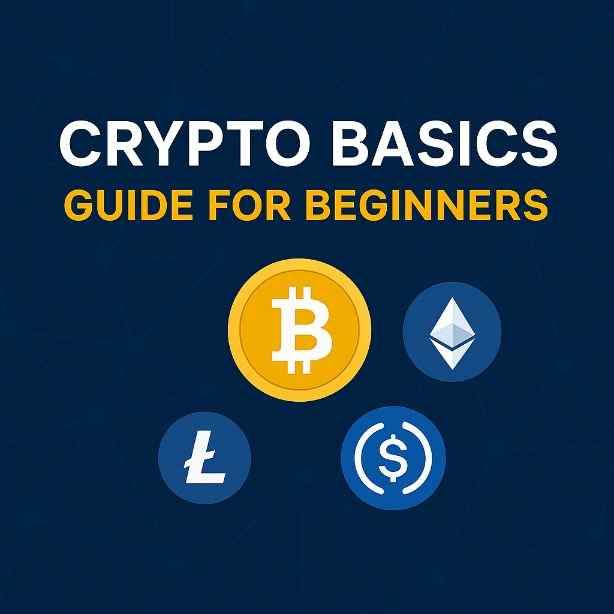Crypto Basics for Beginners step by step. Cryptocurrency is more than a buzzword.
Moreover, It’s the gateway to a new financial future. In this beginner-friendly guide, we’ll explore
Whether you’re curious, cautious, or ready to dive in, this post is your go-to resource.We’ll break it down simply — no technical jargon, no fluff — just clear insights.
You’ll learn what crypto is, also how it works, real-life use cases, and how to safely start your journey. Let’s explore the digital money revolution.
Why Crypto Now? Your Guide for Crypto Basics for Beginners
However, the global economy is evolving. Traditional banks are losing trust. People want independence, faster transactions, and control over their money. That’s where crypto comes in.
However, blockchain technology — the engine behind cryptocurrencies — is transforming everything from finance to supply chains. But many people still feel overwhelmed. That’s why this Crypto Basics for Beginners guide exists: to simplify crypto for you.
You don’t need to be a tech expert to understand crypto. You just need the right explanation.
What Is Cryptocurrency?

At its core, cryptocurrency is digital money. Unlike dollars or euros, it isn’t controlled by a central bank. However, most cryptocurrencies run on blockchain technology—a system that records transactions across many computers. This makes crypto decentralized, secure, and transparent.
Some key features:
- Decentralization: No single authority controls it.
- Transparency: Every transaction is recorded on the blockchain.
- Security: Cryptographic algorithms keep your funds safe.
Also, the most well-known cryptocurrencies include:
- Bitcoin (BTC): The original cryptocurrency, launched in 2009.
- Ethereum (ETH): Known for smart contracts and decentralized apps (dApps).
- Solana (SOL), Cardano (ADA), and others: Each offering unique use cases.
Understanding these currencies is one of the most important crypto basics for beginners.
Recommended by Nova News:
Why People Use Crypto Today Learn more about Crypto Basics
People are drawn to cryptocurrency for many reasons:
1. Financial Freedom
Also, crypto lets users send money globally without banks. It also allows you to hold your own funds, giving full control over your assets.
2. Lower Fees
Also, traditional banking fees can be high. With crypto, you can transfer funds across borders for a fraction of the cost.
3. Investment Opportunities and Crypto Basics for Beginners
First of all, many treat cryptocurrencies like digital gold. Bitcoin and Ethereum, for example, have outperformed traditional investments over the last decade.
4. Privacy
In addition, some cryptocurrencies offer more anonymity than regular banking.
Crypto Basics For Beginners | Real-Life Examples: Crypto in Action
First of all, Let’s explore a few ways people are already using crypto in 2025:
- Remittances: Workers in the U.S. use stablecoins like USDC to send money home to Mexico instantly.
- E-Commerce: Also, online stores accept Bitcoin and Ethereum for products, from laptops to clothing.
- Gaming: Players earn crypto in popular games like Axie Infinity and Illuvium.
- Saving and Lending: DeFi platforms like Aave or Compound let users earn interest by lending crypto.
These examples show why learning crypto basics for beginners can open up new financial opportunities.
Crypto Basics: How Does Blockchain Work?
In addition, Blockchain is the tech behind most cryptocurrencies. Here’s a simple breakdown:
- A transaction is made (Alice sends 1 BTC to Bob).
- First of all the transaction is broadcast to a peer-to-peer network.
- Miners or validators confirm it using computing power.
- The transaction is added to a block.
- The block is linked to the previous block—forming a “chain.”
This process prevents fraud and keeps everything transparent.
What You Need to Start With Crypto Basics For Beginners
Before you buy your first crypto, here’s what you need:
1. A Wallet
However, Crypto wallets hold your private keys. There are two main types:
- Hot Wallets: Connected to the internet. Examples: Coinbase Wallet, MetaMask.
- Cold Wallets: Offline and more secure. Examples: Ledger, Trezor.
2. A Crypto Exchange
This is where you buy, sell, and trade crypto. Additionally Popular platforms include:
Also you must to know, always choose platforms that are secure and beginner-friendly.
3. A Secure Backup
Never lose your private keys or seed phrase. If you do, you lose your funds—forever.
4. Basic Knowledge about Crypto Basics for Beginners
First of all, It’s important to understand crypto basics for beginners before making your first investment. Mistakes can be costly.
How to Buy Your First Cryptocurrency: Step-by-Step
For more here’s how to start in five simple steps:
Step 1: Choose a Trusted Exchange
Sign up with Coinbase or another reputable exchange.
Step 2: Verify Your Identity
To comply with laws, most exchanges require ID verification.
Step 3: Fund Your Account
You can use your bank account, debit card, or PayPal in most cases.
Step 4: Buy Crypto
Start with a small amount—perhaps $20 of Bitcoin or Ethereum.
Step 5: Store It Safely
Also, transfer your crypto to a personal wallet for better security.
This process is essential in learning crypto basics for beginners.
Recommended by Nova News:
Crypto Basics for Beginners: What Are Altcoins?
Bitcoin isn’t the only game in town. Also, altcoins refer to any cryptocurrency that isn’t Bitcoin. Examples include:
- Ethereum (ETH) – Great for smart contracts.
- Solana (SOL) – Known for speed and low fees.
- Chainlink (LINK) – Connects blockchains with real-world data.
Before investing in altcoins, understand the project behind them. Never buy based on hype alone.
What Are Stablecoins?
Also, stablecoins are digital assets tied to real-world currencies. Example: USDC and USDT are pegged to the U.S. dollar. They offer the speed of crypto without the price swings.
You can use them for:
- Saving
- Trading
- Sending money across borders
They’re an important concept when learning crypto basics for beginners.
Avoiding Scams: Stay Safe in the Crypto World
Crypto is powerful—but also attracts scammers. Here’s how to stay safe:
- Never share your private keys
- Avoid clicking suspicious links
- Use two-factor authentication (2FA)
- Stick to well-known platforms
Security is a vital part of crypto basics for beginners.
Glossary: Key Crypto Terms You Should Know
- Blockchain: A public ledger that records crypto transactions.
- Private Key: Your password to access funds. Also, never share it.
- Gas Fees: Small transaction fees paid on networks like Ethereum.
- NFTs: Non-Fungible Tokens, used to own digital art and assets.
- dApps: Decentralized applications built on blockchain tech.
Understanding these terms makes crypto much easier to navigate.
Learn Crypto Basics for Beginners-Top Mistakes Beginners Make
Learning crypto takes time. Here are common errors to avoid:
- Investing too much too soon
- Ignoring security practices
- Falling for hype coins
- Not understanding fees
However, this guide on crypto basics for beginners aims to help you avoid these pitfalls.
The Future of Cryptocurrency
What’s next for crypto?
- Central Bank Digital Currencies (CBDCs) may become mainstream.
- Bitcoin ETFs will attract more traditional investors.
- Web3 will continue to change how we use the internet.
- AI and crypto are starting to merge for smarter financial tools.
Crypto is evolving fast. Stay updated, stay educated.
Conclusion: Your Crypto Journey Starts Now
You’ve just learned the most essential crypto basics for beginners. Also, from wallets and exchanges to safety tips and blockchain tech, you’re now equipped to take the first step.
Remember:
- Start small.
- Stay safe.
- Keep learning.
In addition, crypto isn’t just for tech geniuses anymore. It’s for everyone—including you.
First of all, so open a wallet, explore your first trade, and join the future of finance. The world of cryptocurrency is waiting.

